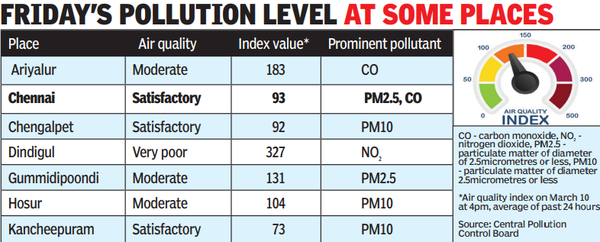- News
- City News
- erode News
- 25 more stations to monitor air quality in six months
Trending
This story is from March 13, 2023
25 more stations to monitor air quality in six months
Rapid urbanisation and industrialisation have had a major impact on air quality standards, compelling policy makers to expand monitoring infrastructure and calculate air quality index in real time. In six months, the Tamil Nadu pollution control board (PCB) would install 25 more continuous ambient air quality monitoring stations in 19 district headquarters and towns with a population of more than one lakh, thus covering the entire state. For the first time, ambient air quality would be continuously monitored in Dharmapuri, Kallakurichi, Kanyakumari, Mayiladuthurai, Perambalur, Sivaganga, Tenkasi, Theni, Tirupattur, Tiruvannamalai, Thiruvarur and Villupuram.

Air quality index recorded on March 10 at 4pm, the average of the past 24 hours

The parameters, including particulate matter of sizes less than 10 and 2.5 microns, sulphur dioxide, nitrogen dioxide, carbon monoxide, ammonia, ozone and benzene, would be monitored round-the-clock and the concentration levels and the Air Quality Index (AQI) would be uploaded on the PCB web portal for public consumption. This is in addition to the 34 existing continuous monitoring stations being operated every day. On Friday, air quality of Dindigul deteriorated to the 'very poor' category as pollution due to nitrogen dioxide soared.

In Tamil Nadu, Chennai, Madurai, Trichy and Tuticorin alone have been categorised as non-attainment cities that have not met the National Air Quality Standards for five years.
"Several efforts are being taken to improve the environment. More stations will come up not only in the industrial belt but even in delta areas at a cost of 40 crore. Existing stations will be upgraded," environment and pollution control minister Siva V Meyyanathan said. Thanjavur, Sivaganga, Tirupattur and Tiruvallur would get two stations each while Chengalpet, a fast-expanding district, would get three stations. Chengalpet, Cuddalore, Erode, Kancheepuram, Thanjavur, Tiruvallur and Virudhunagar would get additional stations.
The PCB would soon engage private players to supply, install and commission the equipment and outsource operation and maintenance for seven years. Under the National Air Quality Monitoring Programme, the PCB established 52 stations and does manual monitoring twice a week. "There are so many micro-climatic areas. If we have less number of stations, we won't get accurate information. We are going to have real time monitoring and have people access information through digital media," said environment, climate change and forest secretary Supriya Sahu. "An integrated monitoring studio, a first of its kind, would also be set up. Real time data would be easy to take immediate action and remediation," said Sahu. The geographical advantage of the state is that the long coastline mitigates air pollution.
End of Article
FOLLOW US ON SOCIAL MEDIA










